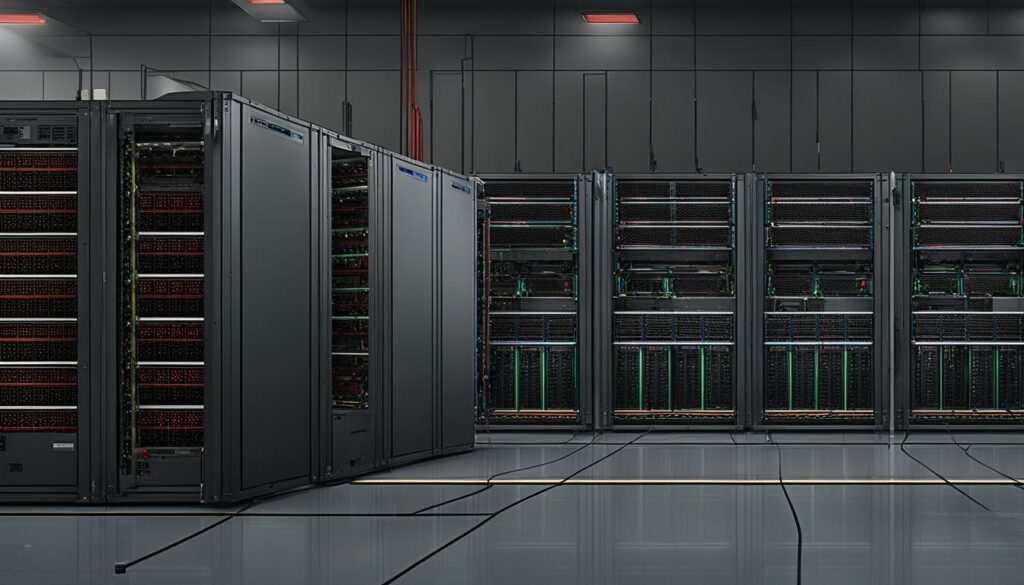Welcome to our comprehensive guide on hosting and network redundancy. In today’s digital world, where connectivity and reliability are paramount, businesses need to ensure their network infrastructure can withstand unexpected disruptions and hardware failures. That’s where network redundancy comes into play.
Network redundancy involves creating backup paths and components within a network infrastructure to ensure uninterrupted connectivity, even in the face of adversity. By implementing network redundancy, businesses can safeguard their operations, improve performance through load balancing, and enhance customer satisfaction by providing a reliable network.
Implementing network redundancy involves various strategies such as load balancing, failover mechanisms, and geographic redundancy. These techniques distribute traffic, automatically switch to backup components, and duplicate critical systems in different locations, respectively. Additionally, network redundancy protocols at different OSI layers, such as Link Aggregation Control Protocol (LACP) and Spanning Tree Protocol (STP), can be utilized.
Key Takeaways:
- Network redundancy ensures uninterrupted operations and minimizes downtime.
- Network redundancy contributes to business continuity and fault tolerance.
- Implementing network redundancy involves load balancing, failover mechanisms, and geographic redundancy.
- Data center redundancy is vital for high availability and minimizing downtime.
- Choosing the right redundancy model for data centers depends on specific needs and requirements.
The Significance of Network Redundancy
Network redundancy plays a crucial role in ensuring uninterrupted operations and minimizing downtime.
When it comes to business continuity, network redundancy provides a safety net by automatically rerouting traffic through alternative paths or components when failures occur. This means that even if one part of the network fails, the system can seamlessly switch to a backup, ensuring that operations can continue without disruptions.
But network redundancy offers more than just business continuity. It also contributes to fault tolerance, which refers to a system’s ability to withstand failures and continue functioning. With redundant systems in place, businesses can maintain a high level of fault tolerance, reducing the risk of service disruptions and potential data loss.
Another benefit of network redundancy is improved performance. By distributing traffic across multiple paths or components, load balancing can be achieved. This helps to prevent any one part of the network from becoming overloaded, ensuring optimized performance and a smooth user experience.
In the unfortunate event of a disaster, network redundancy also plays a crucial role in disaster recovery efforts. By maintaining connectivity through redundant systems, businesses can quickly recover and resume operations, minimizing the impact of the disaster.
Ultimately, network redundancy leads to increased customer satisfaction. With a reliable network that ensures consistent access to services, customers can trust that their needs will be met and their experience will be seamless and uninterrupted.
“Network redundancy is like having a backup plan for your business. It ensures that even in the face of unexpected failures or disasters, you can keep your operations running smoothly, maintain customer satisfaction, and minimize any potential losses.”
Summary:
Network redundancy is essential for business continuity, fault tolerance, improved performance, and disaster recovery. By automatically rerouting traffic, redundant systems ensure uninterrupted operations and minimize downtime. They also contribute to fault tolerance by withstanding failures, improving performance through load balancing, and enhancing disaster recovery efforts. Ultimately, network redundancy leads to customer satisfaction by providing consistent access to services.
Benefits of Network Redundancy
| Benefits | Description |
|---|---|
| Business Continuity | Automatically reroutes traffic through alternative paths or components in the event of failures, ensuring uninterrupted operations. |
| Fault Tolerance | Maintains a high level of system reliability by withstanding failures and reducing the risk of disruptions. |
| Improved Performance | Distributes traffic across multiple paths or components, preventing overloading and optimizing performance. |
| Disaster Recovery | Maintains connectivity during disasters, enabling quick recovery and minimizing the impact of disruptions. |
| Customer Satisfaction | Provides consistent access to services, ensuring a seamless experience for customers. |
Implementing Network Redundancy
Implementing network redundancy is essential for ensuring a reliable and resilient network infrastructure. By employing various strategies such as load balancing, failover mechanisms, geographic redundancy, and network redundancy protocols, businesses can effectively mitigate the risks of hardware failures, unexpected outages, and regional disasters.
Load Balancing
Load balancing is a technique that distributes network traffic across multiple servers or links to prevent overloading and optimize performance. By evenly distributing incoming requests, load balancing ensures that no single server or link gets overwhelmed, thus enhancing the overall responsiveness and availability of network resources.
The implementation of load balancing can significantly improve scalability, as it allows businesses to seamlessly add or remove servers according to fluctuating demand. This flexibility not only optimizes resource utilization but also ensures smooth and uninterrupted network operations even during peak usage periods.
Failover Mechanisms
Failover mechanisms play a critical role in network redundancy by automatically switching to backup components or paths when issues are detected. Whether it’s a hardware failure, a network link outage, or a sudden power loss, failover mechanisms ensure that there are alternative routes and resources readily available to maintain uninterrupted connectivity.
Failover can be achieved through several methods, including virtual IP failover, clustering, and redundant hardware configurations. These mechanisms detect failures and seamlessly redirect traffic to functional components or backup systems, minimizing downtime and ensuring continuous access to network services.
Geographic Redundancy
Geographic redundancy involves duplicating critical network systems in different physical locations to protect against regional disasters, such as earthquakes, hurricanes, or floods. By maintaining replicated infrastructure in separate regions, businesses can ensure that even if one location experiences a catastrophic event, network operations can continue from the unaffected site.
Geographic redundancy not only provides greater fault tolerance but also enhances disaster recovery capabilities. By spreading network resources across multiple locations, businesses can effectively manage data backup and restoration protocols, safeguarding critical information and minimizing data loss during disruptive events.
Network Redundancy Protocols
Network redundancy protocols are essential in achieving redundancy at different Open Systems Interconnection (OSI) layers. These protocols ensure seamless failover and network recovery by dynamically rerouting traffic and optimizing resource utilization.
Two commonly used network redundancy protocols include:
- Link Aggregation Control Protocol (LACP): LACP combines multiple physical network links into a single logical link, providing increased bandwidth and redundancy. By bundling multiple links, LACP enables load balancing and automatic failover, ensuring uninterrupted connectivity even if one or more links fail.
- Spanning Tree Protocol (STP): STP prevents network loops and enables redundant paths in the network. It ensures that a secondary path becomes active if the primary path fails, maintaining network availability and preventing disruptions. STP calculates a tree-like structure and selects the most efficient path to reach network destinations.
Implementing these network redundancy protocols adds an additional layer of reliability and fault tolerance to the network infrastructure, ensuring continuous access to network resources even in the event of failures.

| Network Redundancy Strategies | Benefits |
|---|---|
| Load Balancing |
|
| Failover Mechanisms |
|
| Geographic Redundancy |
|
| Network Redundancy Protocols |
|
Data Center Redundancy for High Availability
Data center redundancy is a critical aspect of ensuring high availability and minimizing downtime for businesses. By employing redundant systems and duplicating components or functions within a data center, organizations can enhance the reliability of their infrastructure and safeguard against failures. Redundancy extends to various aspects of a data center, including servers, storage, cooling systems, network connections, and power supplies.
The redundancy of these components plays a significant role in contributing to operational continuity and business continuity. In the event of a failure or outage, redundant systems can seamlessly take over, ensuring uninterrupted operations and minimizing the risk of data loss. This is particularly crucial for businesses that rely heavily on continuous data availability, such as e-commerce websites, financial institutions, or cloud service providers.
Redundant systems also play a vital role in preventing data loss. By replicating data across multiple servers or storage systems, businesses can protect their valuable information from hardware failures or disasters. This redundant data storage architecture, often implemented through technologies like RAID (Redundant Array of Independent Disks), provides an added layer of data protection and helps minimize the financial and reputational losses that could be incurred due to operational downtimes.
Additionally, data center redundancy ensures high availability by minimizing the impact of planned maintenance or upgrades. By utilizing redundant components or systems, businesses can perform necessary maintenance activities without impacting the availability of their services. This is particularly important for organizations that operate on a 24/7 basis or have stringent service level agreements (SLAs) to meet.
To illustrate the importance of data center redundancy, consider the following scenario: A business relies on a single server to host its website. In the event of a hardware failure, the website would become inaccessible, resulting in potential revenue loss and damaging the customer experience. However, by implementing redundant systems, such as multiple servers with load balancing capabilities, the business can ensure that even if one server fails, the website remains available to users.
Benefits of Data Center Redundancy:
- High availability and minimized downtime
- Data loss prevention
- Operational continuity
- Improved reliability
- Protection against hardware failures

Choosing the Right Redundancy Model for Data Centers
When it comes to data centers, selecting the appropriate redundancy model is crucial for ensuring fault tolerance and operational continuity. There are several redundancy models available, including the N+1 model, 2N model, and 2N+1 model. Each model offers different levels of protection and reliability.
The N+1 model is a popular choice as it provides a backup component for every required component in the data center infrastructure. This redundancy model ensures fault tolerance, minimizing the impact on performance. By having an extra component ready to take over in case of failure, the N+1 model offers a reliable solution.
On the other hand, the 2N model takes redundancy a step further by creating a complete replica of the critical system. This means that every component has a duplicate, ensuring high reliability and fault tolerance. With the 2N model, data centers can withstand component failure without experiencing downtime or service disruption.
For organizations that cannot afford any disruptions, the 2N+1 model offers an additional layer of protection. This model includes an extra backup component, providing enhanced resilience and the ability to handle unexpected failures or peak loads. By going above and beyond the necessary redundancy, the 2N+1 model ensures maximum data center availability.
When comparing data center offerings, it is essential to consider their respective tiers. Data center tiers, ranging from Tier 1 to Tier 4, act as benchmarks for redundancy and availability. Each tier represents a different level of redundancy and operational continuity. The higher the tier, the greater the redundancy and the lower the risk of downtime. It’s important to match the redundancy and availability requirements of your business with the corresponding data center tier.
FAQ
Q: What is network redundancy?
A: Network redundancy involves creating backup paths and components within a network infrastructure to ensure uninterrupted connectivity, even in the face of hardware failures or unexpected outages.
Q: How does network redundancy safeguard business continuity?
A: Network redundancy safeguards business continuity by automatically rerouting traffic through alternative paths or components when failures occur, ensuring uninterrupted operations and minimizing downtime.
Q: What are the benefits of network redundancy?
A: Network redundancy improves performance through load balancing, enhances customer satisfaction by providing a reliable network, and contributes to disaster recovery efforts by maintaining connectivity.
Q: What strategies are involved in implementing network redundancy?
A: Implementing network redundancy involves strategies such as load balancing, failover mechanisms, geographic redundancy, and utilizing redundancy protocols at different OSI layers.
Q: What is data center redundancy?
A: Data center redundancy involves duplicating components or functions within a system to enhance reliability and minimize downtime, safeguarding against failures and contributing to operational continuity.
Q: Why is data center redundancy crucial?
A: Data center redundancy is crucial for protecting data, ensuring uninterrupted business continuity, and minimizing financial and reputational losses caused by operational downtimes.
Q: What redundancy models are available for data centers?
A: Data centers can utilize redundancy models such as the N+1 model, 2N model, and 2N+1 model, each providing different levels of reliability and fault tolerance.
Q: What are data center tiers?
A: Data center tiers, ranging from Tier 1 to Tier 4, serve as benchmarks for comparing the redundancy and availability of data centers, representing different levels of redundancy and operational continuity.












